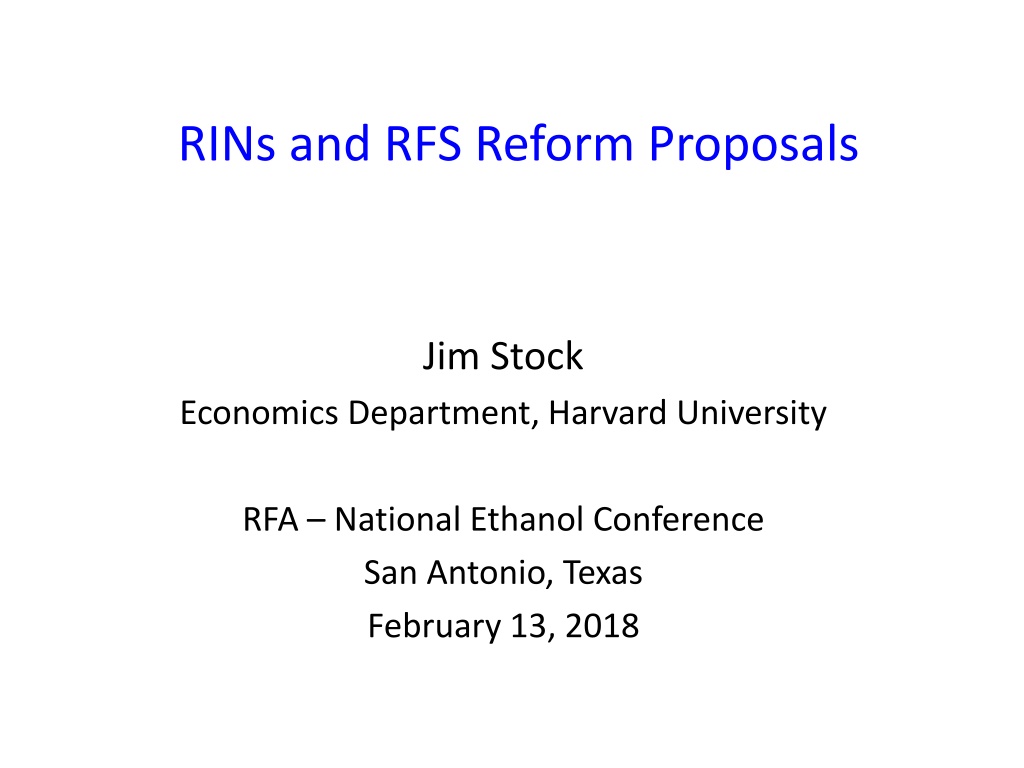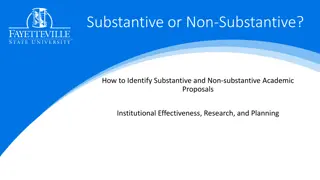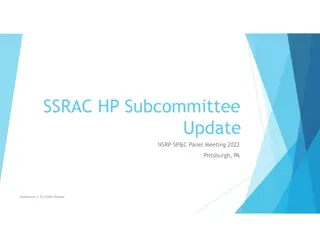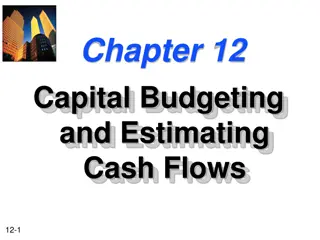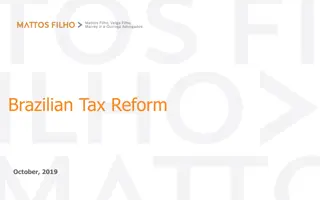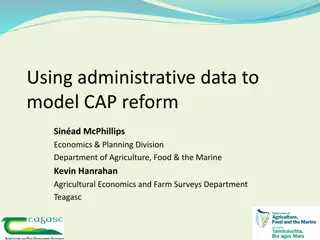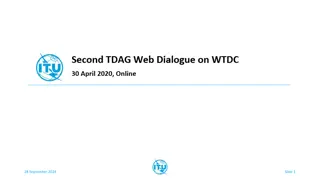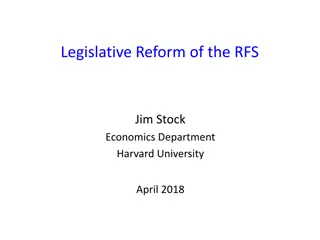RINs and RFS Reform Proposals Overview
The discussion revolves around reform proposals for Renewable Identification Numbers (RINs) and the Renewable Fuel Standard (RFS), emphasizing the need for legislative changes to reduce compliance costs, support higher ethanol blends in the market, and provide reliable backing for second-generation fuels. The presentation covers concepts like the D6/D8 mechanism and RVP E10+ waiver, aiming to address issues and uncertainties in the biofuel policy framework.
Download Presentation

Please find below an Image/Link to download the presentation.
The content on the website is provided AS IS for your information and personal use only. It may not be sold, licensed, or shared on other websites without obtaining consent from the author.If you encounter any issues during the download, it is possible that the publisher has removed the file from their server.
You are allowed to download the files provided on this website for personal or commercial use, subject to the condition that they are used lawfully. All files are the property of their respective owners.
The content on the website is provided AS IS for your information and personal use only. It may not be sold, licensed, or shared on other websites without obtaining consent from the author.
E N D
Presentation Transcript
RINs and RFS Reform Proposals Jim Stock Economics Department, Harvard University RFA National Ethanol Conference San Antonio, Texas February 13, 2018
RFS in the news (again) WASHINGTON (Reuters), Feb. 1, 2018 The head of the U.S. Environmental Protection Agency said on Thursday that the recent bankruptcy of a Pennsylvania oil refiner [Philadelphia Energy Solutions] was evidence the nation s biofuel policy needs an overhaul EPA chief Scott Pruitt said in an interview with Fox News that the bankruptcy largely stemmed from the RFS, and cited the program s requirement that refiners earn or purchase biofuel blending credits called RINs to prove to the EPA that they were meeting their obligations. We need RIN reform, Pruitt said. 2
Legislative Reform of the RFS Reform goals 1. Reduce compliance costs and compliance uncertainty (risk exposure) to obligated parties; 2. Create a path so that higher ethanol blends can compete in the marketplace, with no backsliding on E10; and 3. Provide meaningful and reliable support for second-generation fuels. 3
Legislative Reform of the RFS Reform goals 1. Reduce compliance costs and compliance uncertainty (risk exposure) to obligated parties; 2. Create a path so that higher ethanol blends can compete in the marketplace, with no backsliding on E10; and 3. Provide meaningful and reliable support for second-generation fuels. Prototype reform package 1. The D6-D8 mechanism 2. RVP waiver for E10+ and no backsliding on E10 3. 2nd Gen reforms Stabilize 2ndgen RIN prices, don t make 2nd gen compete with 1st gen, focus 2nd gen part of program on technology development, redefine in terms of GHG reductions not feed stocks, simplify pathway approvals, 4
Legislative Reform of the RFS This presentation 1. The D6/D8 mechanism What is it? How would it work in practice? 2. The RVP E10+ waiver 3. What would be the economic effect of D6/D8 & E10+ RVP waiver? Warning label: The package is a moving target! And the details matter! 5
The D6/D8 Concept: Motivation What if the RIN obligation only had to be paid on the part of conventional that is not E10? Illustrative calculation: Currently, ethanol in E10 14.2 Bgal Conventional RVO ex ethanol in E10 = 15 14.2 = 0.8 Bgal Say D6 RIN price is $0.75 Value of total D6 RIN obligation: Now: $0.75 15 Bgal = $11.25 B Ex ethanol in E10: $0.75 0.8 Bgal = $600m a 95% reduction! 6
The Current RFS Nesting Structure Cellulosic (D3) Biomass- based diesel (D4) Advanced (D5) Conventional (D6) 7
A Prototype D6/D8 nesting structure Examples: 1 gal E10 0.10 D6 and 0 D8 1 gal E15 0.10 D6 and 0.05 D8 1 gal conventional renewable diesel 1.7 D8 RINs 9
A Prototype D6/D8 nesting structure Examples: 1 gal E10 0.10 D6 and 0 D8 1 gal E15 0.10 D6 and 0.05 D8 1 gal conventional renewable diesel 1.7 D8 RINs Mechanics: Generation by producer (as now) Detaching upon blending (as now) 10
A Prototype D6/D8 nesting structure Examples: 1 gal E10 0.10 D6 and 0 D8 1 gal E15 0.10 D6 and 0.05 D8 1 gal conventional renewable diesel 1.7 D8 RINs Mechanics: Generation by producer (as now) Detaching upon blending (as now) RIN prices D6 RVO is set so that D6 is always in oversupply, so D6 RIN price is ~0 D8 and D4 pricing would be like current D6 and D4 pricing 11
The E10+ RVP Waiver E10 is granted a 1 pound waiver so that it can be sold year-round. This is the existing E10 RVP waiver. The proposed RVP waiver would extend this to all blends E10+, so E15 could be sold year-round. Economic effect of E10+ RVP waiver: Increased demand for E15 Reduced pressure on conventional RIN price 12
Economic Implications of D6/D8 & E10+ RVP Waiver RIN prices: D6 0 D8 - less than current D6 (because of RVP waiver) D4 same or less than current D4 (at or above D8 price) RIN price volatility potentially reduced substantially Fuel prices (all changes are in the pennies): BOB price down E10 pump price up Diesel pump price down E15-E10 & E85-E10 spreads about same as now E0-E10 spread down E100 & distillers margins no effect Ethanol sales Up, but by how much depends on success of E15 marketing 13
RFS Reform The details matter! No-backsliding provisions Must include second generation reform 14
Possible Separate Nesting Structures and New RIN Categories 16
The D6/D8 Mechanism & Economics Additional Detail Upon production, ethanol generates a D6-8 parent RIN Ethanol blended to 10% of gasoline detaches a D6 RIN All other conventional fuels detach a D8 RIN upon blending Blending 1 gal E15 separates 0.10 D6 and 0.05 D8 RINs Ownership of the D6 and D8 RINs remain (as now) with the owner of the upstream ethanol As now: D6, D8 RINs are bankable and tradeable Conventional BBD generates a D8 RIN 17
Economics of the E10+ RVP Waiver Effect of RVP waiver for E10+: More E15, less CBBD 18
